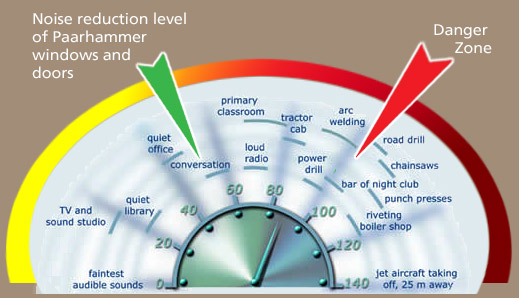Click here to view our latest blog
Stop the noise!

With all the hustle and bustle in our daily life we crave peace and quiet in our homes. But noise from roads, planes or neighbours disturb our well-earned
relaxation time. Stop the noise and create a quiet oasis with Paarhammer windows and doors!
Noise is accepted to be the fastest growing type of pollution in modern cities, and its effect on our mental and emotional health has a direct influence
on our physical well-being, everything from lack of sleep to increased stress, heart attacks and strokes. Our health suffers if there is a constant
noise level and our bodies and brain cannot regenerate.
We need sound to communicate and unexpected noise may warn us of danger. Sounds we hear tell us a lot about our surroundings. Frequency, wavelength,
pressure and speed of sound all have an influence on how we perceive it.
Sound pressure level (sound intensity) is measured in decibel (dB), a logarithmic unit. Each 10dB increase is an increase of sound by ten times, e.g.
a sound at 20dB has ten times more energy than at 10dB. And a sound at 30dB has 10x10 (so 100 times) more energy than at 10dB. Or maybe an easier way
to calculate: every 3dB increase is approximately a doubling of the sound intensity or acoustic power.
But our ears hear sound differently. The normal range of hearing extends from 0 dB (hearing threshold) to around 130 dB (pain threshold). A difference
of 10 dB halves / doubles the noise, e.g. if the sound pressure level was increased by 10dB then we would feel that the sound was twice as loud, so
a noise increase from 60dB to 70dB would seem to have doubled. If it was reduced by 10dB then we would feel that the noise had halved so a decrease
from 60 to 50dB.
Sound is a vibration that transmits as a typically audible mechanical wave of pressure and displacement, through a medium such as air. Airborne noise
can be greatly reduced in our homes by eliminating air from entering, e.g. airtight homes equal quiet homes. Paarhammer air infiltration starts from
a very low 0.05% for openable products like tilt and turn windows.
When specifying building materials, especially windows and doors, ensure low air infiltration. In addition, specify double glazing with different thicknesses
of each pane of glass to catch different wavelengths, thereby reducing noise levels.
Recently Paarhammer had their products tested for noise reduction by the CSIRO with excellent results. Even our standard double glazed windows achieved
a sound protection of 42dB. This can increase to 45dB with a noise controlling or special acoustic glass in double glazed panes and the option of a
second seal, meaning we can cut down noise by up to 80-90%.
Just image what these products could do for your quality of life!
References and specific information on noise reducing glass, read: Can noise pollution damage your health? in The Conversation